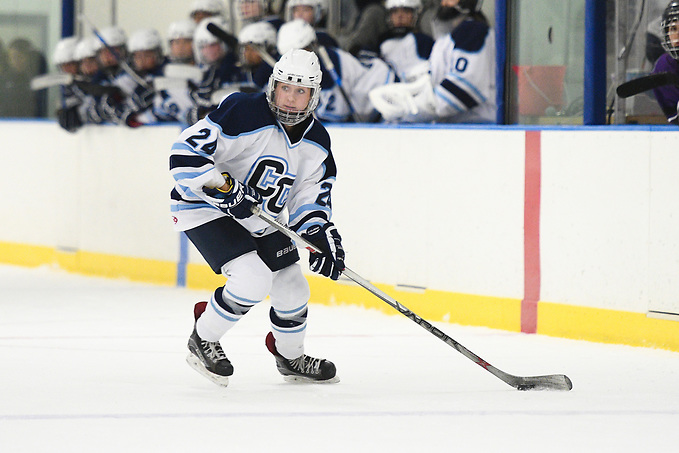
For the second straight season, Connecticut College started the season outside the polls, but by January found themselves ranked among the nation’s best.
They say slow and steady wins the race, and the Connecticut College Camels seem to be embodying that mantra. Ironically, they often do so by outskating their opponents.
The Camels are a bit of a rarity in Division III hockey — they roll four lines most of the time, and the team plays a fast, run-and-gun style of hockey. They’re not the flashiest team an opponent will face, but they are dangerous around the net, and though they can’t control the relative talent of their roster to someone else’s, they can make sure they’re the first ones to the puck.
“I think we’re hard-working and we’re gritty,” said senior forward Lily Connolly. “Most of our goals are hard-work, back-door plays or rebound goals.”
For the past three seasons, the Camels have played four of their first five games against their two toughest conference rivals — Amherst and Middlebury. Both teams are currently ranked in the top 10 nationally. Middlebury has a one-point lead atop the NESCAC, and Amherst and Connecticut College are tied for second place.
Two seasons ago, the Camels took a single point in those four games. This year, it was three wins and a loss, including a sweep of Amherst, who ousted them from the NESCAC tournament semifinals last season, and a come-from-behind overtime win over Middlebury. The team has just been building from there, said Connolly. That team from two years ago set a program record for wins with 15, and last year’s team matched it. At 12-3-3 with six games to go in the regular season, this season’s squad is well on the way to setting a new high bar.
One main reason they’ve been successful, said freshman Erin Dillon, is how close the team is and how quickly that closeness came about. She felt comfortable at Connecticut College almost immediately. In their shorter season, NESCAC teams have an even more condensed schedule, which can make it hard to build to the postseason. They’re interrupted by winter break after just seven games, meaning teams have to work extra hard to build chemistry.
Dillon said the Camels do a great job integrating the rookies before anyone ever steps on the ice. From group chats to captain’s practices, there’s an increased focus on finding their balance as a team off the ice so that when they do finally get to skate, they don’t feel like they’re behind everyone else. There’s nothing quite like optional practices at 6:30 a.m. to make players feel bonded, said Dillon.
“The team chemistry on and off the ice really plays into (our readiness),” Dillon said. “We kind of just hype each other up and play for the person that’s sitting next to you in the locker room.”
Building on both the earlier successes and missteps is what’s helped the Camels achieve what they have so far this season. This close to the end of the year and with conference standings so close, it can get easy to look ahead and lose sight of immediate goals, but Connolly said they only scoreboard watch insomuch as it provides them motivation. When they’re unranked, it pushes them to feel like they have to prove something. If they lose and drop down in the rankings, it’s motivation to recover and regain their position.
“At the beginning of the season, we discuss our goals, and obviously our long-term, main goal is to work toward a championship,” said Connolly. “For short-term goals, we take it game by game, and we make sure to say that the most important game is the game that we’re playing right now. Obviously if we’re able to play well in those games and win those games, that’s eventually going to lead us to a championship.”
The past few seasons have done nothing but build confidence both for the players individually and the program as a whole. Connolly said that’s the biggest change she feels on the ice this season. The Camels are an interesting mix of top-level contender and haven’t-quite-made-it-there dark horse. They haven’t quite reached the finish line, but they’re steadily getting there. In the meantime, the players are enjoying their position as an under-the-radar threat.
“I think that we have a great group of girls that are willing to put in the work to win these games and win every shift; we kind of take it day by day,” said Dillion. “It’s fun to be that underdog. People don’t expect us to be as successful as we are. It kind of pushes us to prove them wrong.”


